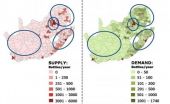(Press-News.org) Calorie listings on fast-food chain restaurant menus might meet federal labeling requirements but don't do a good job of helping consumers trying to make healthy meal choices, a new Columbia University School of Nursing (CUSON) study reports.
The study, by Elizabeth Gross Cohn, RN, NP, DNSc, assistant professor of nursing at CUSON, and colleagues, was published online on February 16, 2012, in the Journal of Urban Health. The researchers studied the calorie counts for 200 food items on menu boards in fast-food chain restaurants in the New York inner-city neighborhood of Harlem. Since 2006, the City has had a standard menu labeling law that includes some, though not all, of the new federal requirements.
"Although most postings were legally compliant, they did not demonstrate utility," the authors say. "Menu postings for individual servings are easily understood, but complex math skills are needed to interpret meals designed to serve more than one person. In some items, calories doubled depending on flavor, and the calorie posting did not give enough information to make healthier selections."
The federal health reform law passed in March 2010 requires restaurants with 20 or more locations to provide calorie data and additional nutritional information for menu items and self-service foods. The Food and Drug Administration is now considering how best to guide chain restaurants in posting calorie counts on menu boards.
Easily understood calorie listings could be helpful to consumers trying to make healthy food choices, especially in light of the increasing prevalence of obesity among American adults and children. The trend is a particular problem in low-income and inner-city neighborhoods, where sources of more healthful foods might not be as common as fast-food fare. Studies suggest that consumers are generally unaware of, or inaccurately estimate, the number of calories in restaurant foods.
To collect the data, volunteers equipped with digital cameras worked in pairs and canvassed each designated area block by block to identify national restaurant outlets. A total of 70 menus and menu boards from 12 restaurant chains were photographed, and 200 food items rated, using a measure of "practical utility" that the researchers developed to calculate (1) what constitutes a single serving and (2) the number of calories in a single serving. The researchers then combined this measure with current FDA guidelines to develop a seven-item "menu rating tool."
The researchers found that, while most restaurants studied have posted calorie counts, in the majority of cases there was insufficient information to make use of them at the point of purchase. One reason for this was that the majority of the items on the menu boards studied were combination meals rather than individual items. Furthermore, it was increasingly difficult to calculate calories per meal when the posting included anything more than an individual unit of measure.
Calorie counts became more challenging as the food items became more complex, especially combination and multi-serving items, which represented the largest percentage of items recorded. These required several mathematical and nutritional calculations, which might be more challenging among low socioeconomic groups in urban areas where fast-food chain restaurants tend to be most concentrated.
For example, the study reports, a bucket of chicken was listed as 3,240 to 12,360 calories, but the menu board did not contain enough information to determine the number of pieces of chicken in a serving size. Similarly, a hero combo meal ranged from 500 to 2,080 calories, but no information was provided on how a consumer would order within the lower range of this menu item. Specialty pizzas were offered in wide ranges without a clear explanation as to how they differed, since the calorie count was based on a standard size and standard set of toppings.
The authors note that their study was limited to one urban community and did not focus on actual food purchasing behavior but rather on the posted menu boards in chain restaurants. Still, they say, their work suggests the need for more understandable and useful calorie information in posted menus.
"As further legislation is developed, we support the FDA in their commitment to having menu boards that are useful at all levels of literacy," they conclude. Specifically, the authors support a system that uses dashes or slashes to more intuitively associate calorie counts to food combinations instead of the current system of ranges. In such a revised system, a breakfast sandwich, for example, would be listed as "egg with ham/bacon/sausage 350/550/750."
"In low-income communities with a high density of chain restaurants, and where educational attainment of consumers may be low, simplifying calorie postings and minimizing the math required to calculate calories would increase menu board utility," they say.
###
The study's authors are Elizabeth Gross Cohn, Elaine L. Larson, Christina Araujo, Vanessa Sawyer, and Olajide Williams.
The authors report no financial or other conflict of interest.
About the Columbia University School of Nursing
Since its founding in 1892, the Columbia University School of Nursing (CUSON) has been dedicated to preparing clinically excellent nurses, nurse practitioners, clinical nurse specialists, and scholars. As nursing educators and clinical professionals, CUSON faculty focus on addressing the needs of underserved and vulnerable populations, both in practice and research. Today, CUSON has clinical partnerships at more than 200 clinical practice sites throughout New York City and affiliations with three major medical centers. CUSON has a long history of "firsts," including awarding a master's degree in a clinical nursing specialty, developing the Doctor of Nursing Practice degree, having its faculty gain full admitting privileges to a major teaching hospital, and being designated a World Health Organization Collaborating Center for Advanced Practice Nursing. CUSON also is among the highest-ranked nursing schools in federal research grants awarded per faculty. Visit CUSON at www.nursing.columbia.edu.
END
San Diego, Calif. – When bacteria wage a turf war, some of the combatants have an extra weapon. Certain strains of the bacteria E. coli produce proteins that kill competing E. coli and other like microbes, and researchers from Newcastle University in England have recently discovered something surprising about one of these lethal proteins: even after the toxic folded portion of the protein is removed, the unfolded end is still deadly. The finding may one day help scientists find new, more targeted ways to kill antibiotic-resistant microbes. The researchers will present their ...
EAST LANSING, Mich. — The deaths of at least 13 workers who were refinishing bathtubs have been linked to a chemical used in products to strip surfaces of paint and other finishes.
An investigation started by researchers at Michigan State University in 2011 has found that 13 deaths since 2000 – including three in Michigan – involved the use of paint-stripping products containing methylene chloride, a highly volatile, colorless and toxic chemical that is widely used as a degreaser and paint stripper. The chemical, in addition to being used in industrial settings, is available ...
Lloyds TSB today announces that it will offer a Junior Cash ISA, making it the first of the major high street banks to do so.
- Lloyds TSB is the first of the major high street banks to announce a Junior Cash ISA
- Account available from 13th February, meaning parents can take full advantage of the GBP3,600 annual Junior ISA allowance for 2011 / 2012
- New research indicates young adults increasingly reliant on financial support from their parents in their adult life
- Lloyds TSB urges the Government to allow parents to transfer Child Trust Fund accounts to Junior ...
In the developing world, allocating limited health care resources as effectively and equitably as possible is a top priority.
To address that need, systems engineers at the Georgia Institute of Technology are using computer models to help resource-poor nations improve supply chain decisions related to the distribution of breast milk and non-pharmaceutical interventions for malaria. They are also forecasting what health care services would be available in the event of natural disasters in Caribbean nations.
"We are using mathematical models implemented in user-friendly ...
The Bar Code News (www.barcode.com)--the online magazine dedicated to being the "Go-To Site for everything Bar Code "-- recently announced new email subscription options. Subscribers can now opt for free daily, weekly, or monthly electronic newsletters delivered to their email inbox. Free quarterly print editions of The Bar Code News will also be sent, beginning in 2012, to those who enter a valid mailing address into the subscription form.
The Bar Code News, owned by Barcode Media Group, Inc., offers industry news, case studies, educational resources, videos, ...
San Diego, Calif. – Several neurodegenerative diseases – including Alzheimer's and ALS (Lou Gehrig's disease) – are caused when the body's own proteins fold incorrectly, recruit and convert healthy proteins to the misfolded form, and aggregate in large clumps that gum up the works of the nervous system. "For Star Trek fans, this is like the Borg, [a fictional race of cyborgs that abduct and assimilate humans and other species]," says Steven Plotkin, a biophysicist at the University of British Columbia in Vancouver who studies the process of protein misfolding.
Plotkin's ...
CORVALLIS, Ore. – Researchers at Oregon State University have discovered a way to make a low-cost material that might accomplish negative refraction of light and other radiation – a goal first theorized in 1861 by a giant of science, Scottish physicist James Maxwell, that has still eluded wide practical use.
Other materials can do this but they are based on costly, complex crystalline materials. A low-cost way that yields the same result will have extraordinary possibilities, experts say – ranging from a "super lens" to energy harvesting, machine vision or "stealth" coatings ...
As another cold British winter passes by many British tourists are making plans to head off on long weekends and trips to the sunshine during the spring. With that in mind Carrentals.co.uk has sourced new prices to let people rent a car for less on trips to the beaches of Cyprus or for long weekends on the north-west coast of England.
The island of Cyprus remains as popular a destination as ever for UK travellers and tourists, with its mix of sunshine, beautiful beaches and a warm welcome from locals. Many Brits choose to fly into Cyprus' Larnaca Airport, and right now ...
San Diego, Calif. – Each year, phytoplankton blooms known as "red tides" kill millions of fish and other marine organisms and blanket vast areas of coastal water around the world. Though the precise causes of red tides remain a mystery, a team of researchers in the United States and Spain has solved one of the main riddles about these ecological disasters by uncovering the specific mechanism that triggers phytoplankton to release their powerful toxins into the environment.
"Previous theories about how phytoplankton release toxins proposed a rather awkward, untested 'exudation' ...
Under a microscope, a tiny droplet slides between two fine hairs like a roller coaster on a set of rails until — poof — it suddenly spreads along them, a droplet no more.
That instant of change, like the popping of soap bubble, comes so suddenly that it seems almost magical. But describing it, and mapping out how droplets stretch into tiny columns, is a key to understanding how liquids affect fibrous materials from air filters to human hair. And that knowledge allows scientists to better describe why water soaks into some materials, beads atop others and leaves others ...



